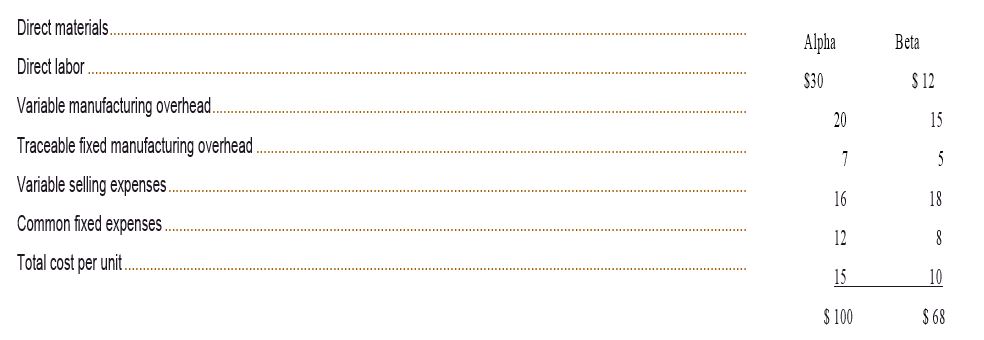
MANAGERIAL ACCOUNTING CONNECT ACCESS
17th Edition
ISBN: 9781265750879
Author: Garrison
Publisher: MCG
expand_more
expand_more
format_list_bulleted
Concept explainers
Textbook Question
thumb_up100%
Chapter 13, Problem 1F15
Cane Company manufactures two products called .Alpha and Beta that sell for $120 and $80: respectively. Each product uses only one type of raw material that costs $6 per pound. The company has the capacity7 to annually produce 100,000 units of each product. Its average cost per unit for each product at this level of activity are given below:

The company considers its traceable fixed manufacturing
Required:
(Answer each question independently unless instructed otherwise.)
1. What is the total amount of traceable fixed manufacturing overhead for each of the two products?
Expert Solution & Answer
Want to see the full answer?
Check out a sample textbook solution
Students have asked these similar questions
Goodwill is an example of an indefinite-life intangible asset, meaning that public companies must test it for impairment rather than regularly amortizing to systematically reduce its value on the balance sheet of the public company.
Can anyone recap the difference between limited-life versus indefinite-life intangible assets? Any specific examples of either category?
Why are adjusting journal entries necessary at the end of an accounting period? Need he
Why are adjusting journal entries necessary at the end of an accounting period?i need help
Chapter 13 Solutions
MANAGERIAL ACCOUNTING CONNECT ACCESS
Ch. 13.A - EXERCISE 12A-1 Absorption Costing Approach to...Ch. 13.A - EXERCISE 12A-2 Customer Latitude and Pricing...Ch. 13.A - Prob. 3ECh. 13.A - Prob. 4ECh. 13.A - Prob. 5ECh. 13.A - EXERCISE 12A-6 Value-Based Pricing; Absorption...Ch. 13.A - Prob. 7ECh. 13.A - Prob. 8PCh. 13.A - Prob. 9PCh. 13.A - Prob. 10P
Ch. 13.A - Prob. 11PCh. 13.A -
PROBLEM 12A-12 Absorption Costing Approach to...Ch. 13.A - PROBLEM 12A-13 Value-Based Pricing LO12-10 The...Ch. 13 - Prob. 1QCh. 13 - Prob. 2QCh. 13 - Prob. 3QCh. 13 - Prob. 4QCh. 13 - “Variable costs and differential costs mean the...Ch. 13 - 12-6 "All future costs are relevant in decision...Ch. 13 - Prentice Company is considering dropping one of...Ch. 13 - Prob. 8QCh. 13 - 12-9 What is the danger in allocating common fixed...Ch. 13 - 12-10 How does opportunity cost enter into a make...Ch. 13 - 12-11 Give at least four examples of possible...Ch. 13 - 12-12 How will relating product contribution...Ch. 13 - Define the following terms: joint products, joint...Ch. 13 - 12-14 From a decision-making point of view, should...Ch. 13 - What guideline should be used in determining...Ch. 13 - Prob. 16QCh. 13 - Prob. 1AECh. 13 - Prob. 2AECh. 13 - Cane Company manufactures two products called...Ch. 13 - (
Alpha Beta
$30
$...Ch. 13 - Prob. 3F15Ch. 13 - Prob. 4F15Ch. 13 - Prob. 5F15Ch. 13 - (
Alpha Beta
$30
$...Ch. 13 - Prob. 7F15Ch. 13 -
Cane Company manufactures two products called...Ch. 13 - Prob. 9F15Ch. 13 - (
Alpha Beta
$30
$...Ch. 13 - Prob. 11F15Ch. 13 - Prob. 12F15Ch. 13 - (
Alpha ...Ch. 13 - (
Alpha Beta
$30
$...Ch. 13 - (
Alpha Beta
$30
$...Ch. 13 -
EXERCISE 12-1 Identifying Relevant Costs...Ch. 13 -
EXERCISE 12-2 Dropping or Retaining a Segment...Ch. 13 -
EXERCISE 12-3 Make or Buy Decision LO12-3
Troy...Ch. 13 -
EXERCISE 12-4 Special Order Decision...Ch. 13 -
EXERCISE 12-5 Volume Trade-Off Decisions...Ch. 13 - Prob. 6ECh. 13 - Prob. 7ECh. 13 - Prob. 8ECh. 13 - Prob. 9ECh. 13 - Prob. 10ECh. 13 - (
$3.60
10.00
2.40
9.00
$25.00
)
EXERCISE 12-11...Ch. 13 - Prob. 12ECh. 13 - EXERCISE 12-13 Sell or Process Further Decision...Ch. 13 - en
r
Ch. 13 - Prob. 15ECh. 13 - (
$150
31
20
29
3
24
15
$272
$34
)
EXERCISE...Ch. 13 - Prob. 17ECh. 13 - Prob. 18PCh. 13 - PROBLEM 12-19 Dropping or Retaining a Segment...Ch. 13 -
PROBLEM 12-20 Sell or Process Further Decision...Ch. 13 - Prob. 21PCh. 13 - PROBLEM 12-22 Special Order Decisions LO12-4...Ch. 13 -
PROBLEM 12-23 Make or Buy Decision LO12-3
Silven...Ch. 13 - Prob. 24PCh. 13 - Prob. 25PCh. 13 - Prob. 26PCh. 13 - Prob. 27PCh. 13 - Prob. 28PCh. 13 - CASE 12-29 Sell or Process Further Decision LO12-7...Ch. 13 -
CASE 12-30 Ethics and the Manager; Shut Dora or...Ch. 13 - CASE 12-31 Integrative Case: Relevant Costs;...Ch. 13 -
CASE 12-32 Make or Buy Decisions; Volume...Ch. 13 - Prob. 33C
Knowledge Booster
Learn more about
Need a deep-dive on the concept behind this application? Look no further. Learn more about this topic, accounting and related others by exploring similar questions and additional content below.Similar questions
arrow_back_ios
SEE MORE QUESTIONS
arrow_forward_ios
Recommended textbooks for you

 AccountingAccountingISBN:9781337272094Author:WARREN, Carl S., Reeve, James M., Duchac, Jonathan E.Publisher:Cengage Learning,
AccountingAccountingISBN:9781337272094Author:WARREN, Carl S., Reeve, James M., Duchac, Jonathan E.Publisher:Cengage Learning, Accounting Information SystemsAccountingISBN:9781337619202Author:Hall, James A.Publisher:Cengage Learning,
Accounting Information SystemsAccountingISBN:9781337619202Author:Hall, James A.Publisher:Cengage Learning, Horngren's Cost Accounting: A Managerial Emphasis...AccountingISBN:9780134475585Author:Srikant M. Datar, Madhav V. RajanPublisher:PEARSON
Horngren's Cost Accounting: A Managerial Emphasis...AccountingISBN:9780134475585Author:Srikant M. Datar, Madhav V. RajanPublisher:PEARSON Intermediate AccountingAccountingISBN:9781259722660Author:J. David Spiceland, Mark W. Nelson, Wayne M ThomasPublisher:McGraw-Hill Education
Intermediate AccountingAccountingISBN:9781259722660Author:J. David Spiceland, Mark W. Nelson, Wayne M ThomasPublisher:McGraw-Hill Education Financial and Managerial AccountingAccountingISBN:9781259726705Author:John J Wild, Ken W. Shaw, Barbara Chiappetta Fundamental Accounting PrinciplesPublisher:McGraw-Hill Education
Financial and Managerial AccountingAccountingISBN:9781259726705Author:John J Wild, Ken W. Shaw, Barbara Chiappetta Fundamental Accounting PrinciplesPublisher:McGraw-Hill Education


Accounting
Accounting
ISBN:9781337272094
Author:WARREN, Carl S., Reeve, James M., Duchac, Jonathan E.
Publisher:Cengage Learning,

Accounting Information Systems
Accounting
ISBN:9781337619202
Author:Hall, James A.
Publisher:Cengage Learning,

Horngren's Cost Accounting: A Managerial Emphasis...
Accounting
ISBN:9780134475585
Author:Srikant M. Datar, Madhav V. Rajan
Publisher:PEARSON

Intermediate Accounting
Accounting
ISBN:9781259722660
Author:J. David Spiceland, Mark W. Nelson, Wayne M Thomas
Publisher:McGraw-Hill Education

Financial and Managerial Accounting
Accounting
ISBN:9781259726705
Author:John J Wild, Ken W. Shaw, Barbara Chiappetta Fundamental Accounting Principles
Publisher:McGraw-Hill Education
Cost Accounting - Definition, Purpose, Types, How it Works?; Author: WallStreetMojo;https://www.youtube.com/watch?v=AwrwUf8vYEY;License: Standard YouTube License, CC-BY